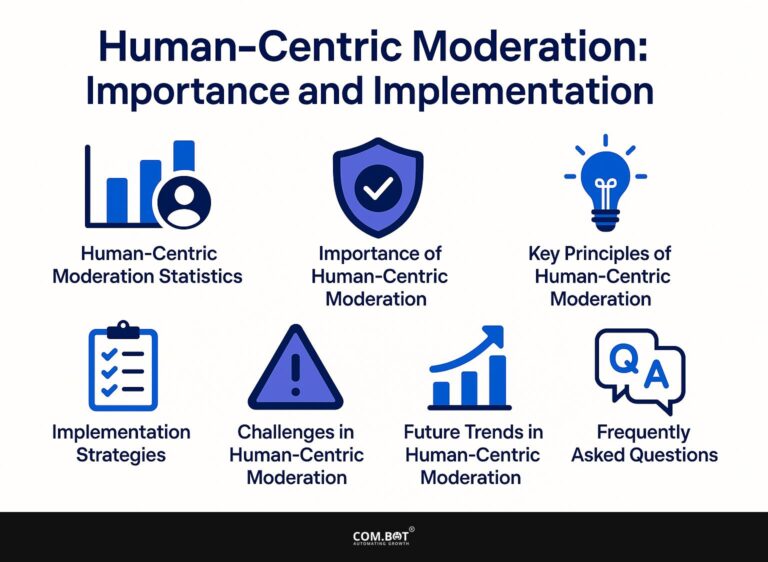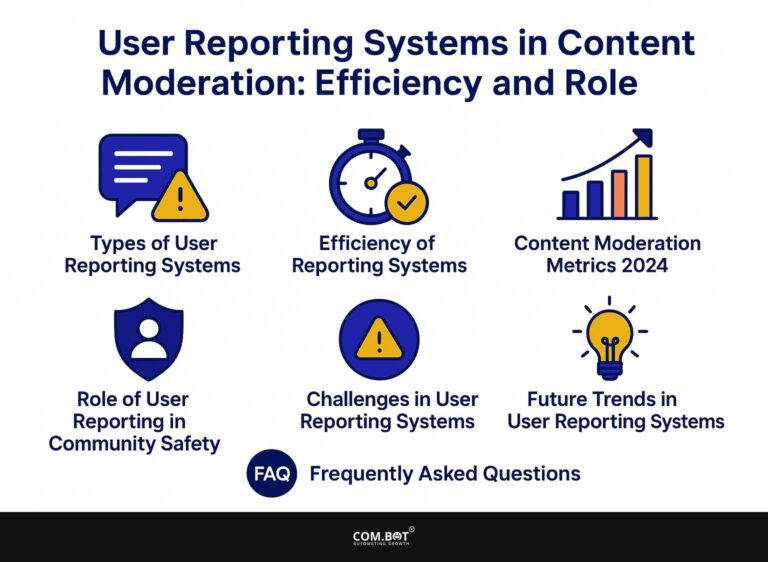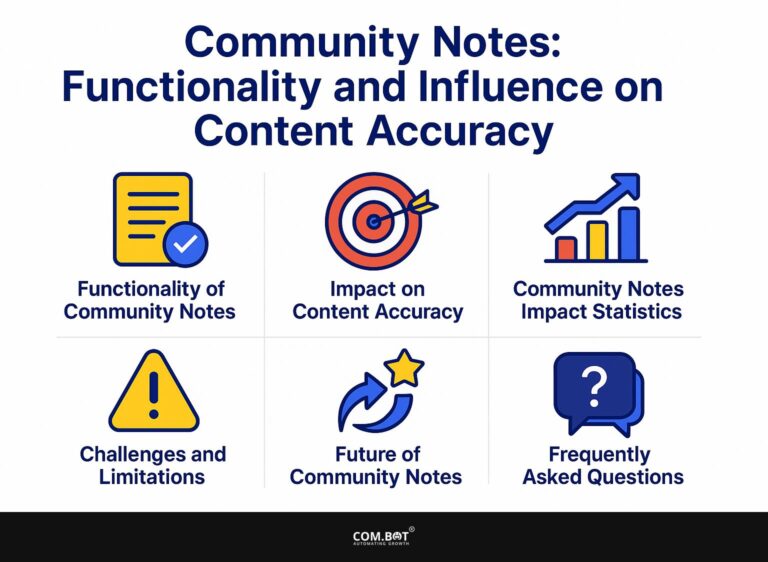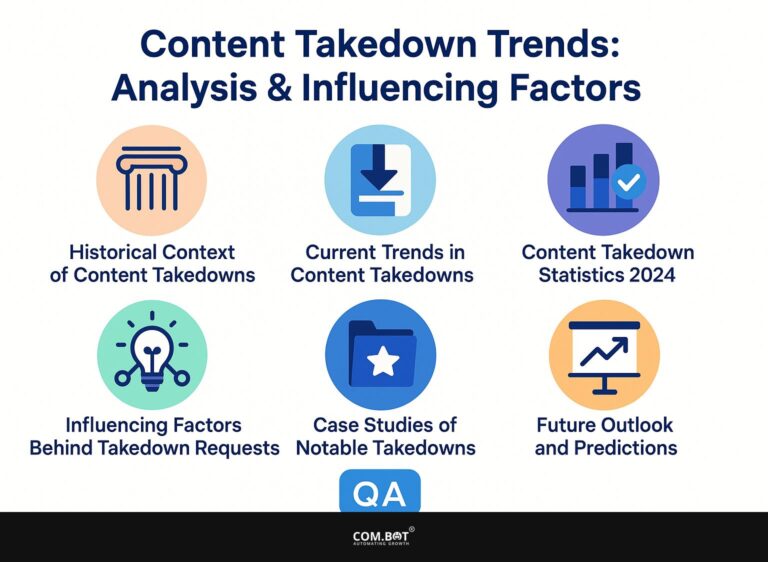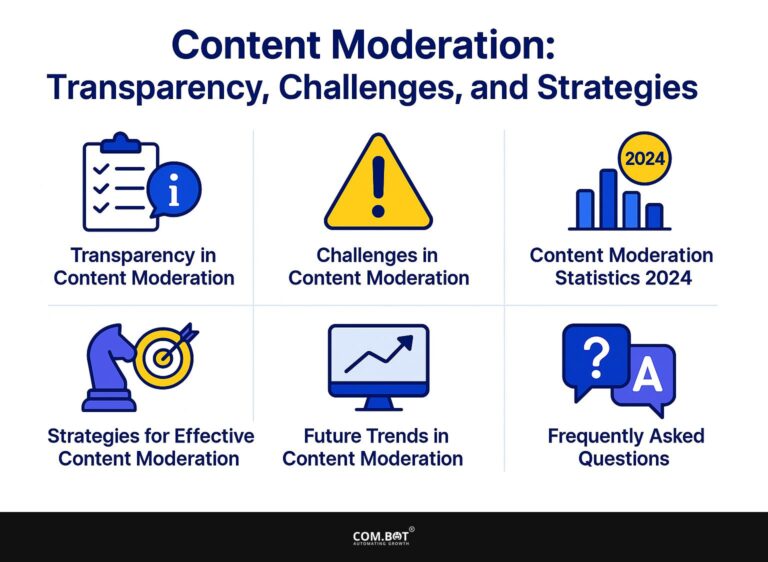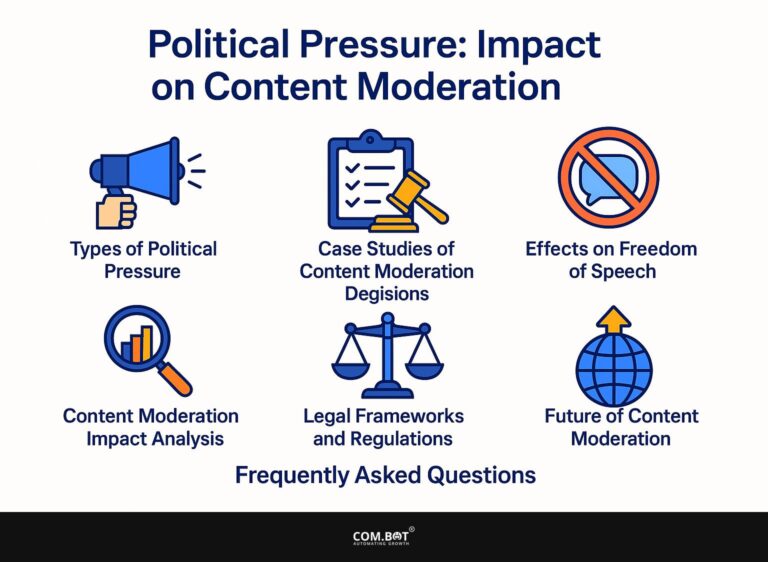Policy Overlap in Content Moderation: Case Studies
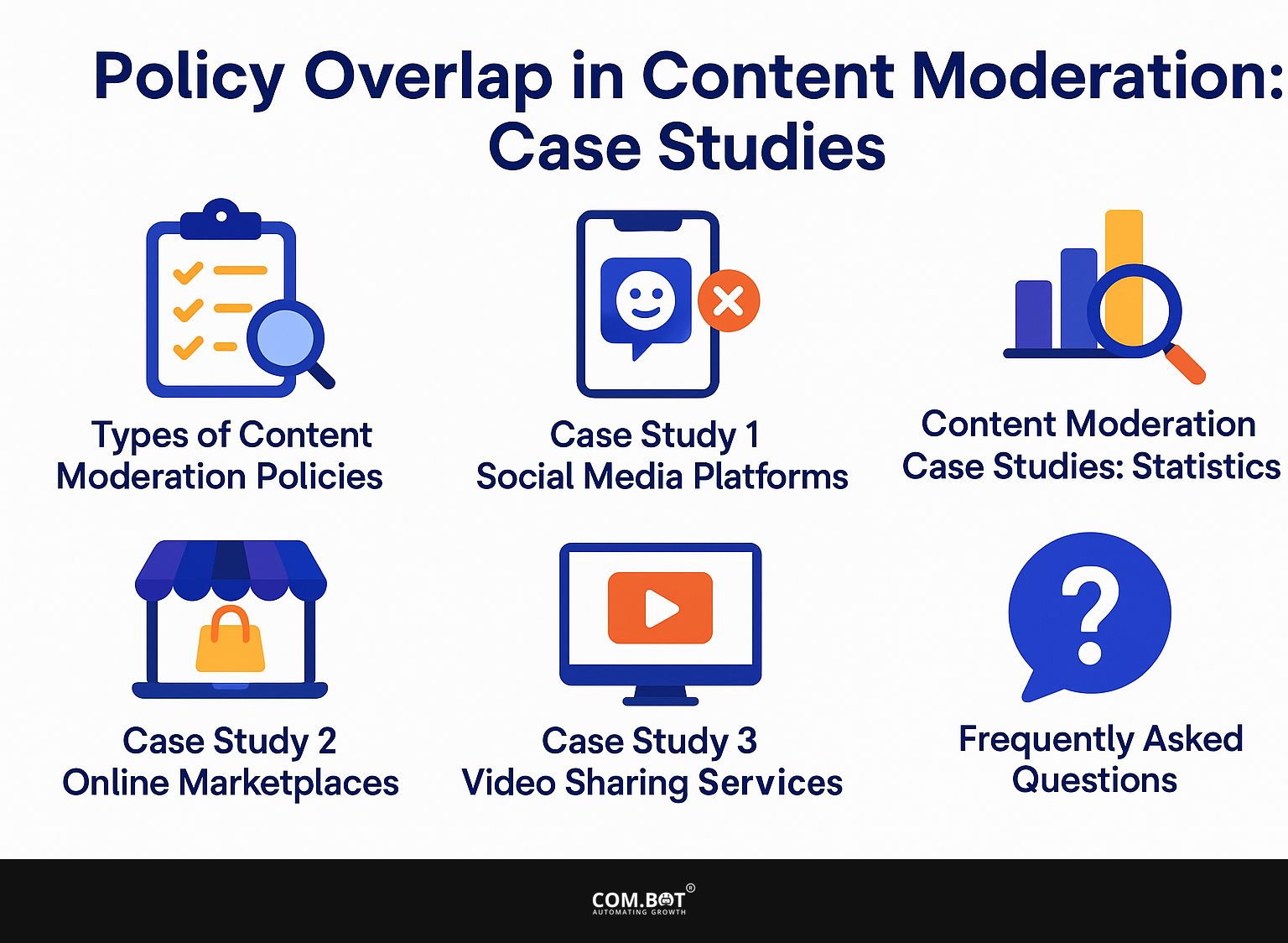
In an age where misinformation spreads rapidly on social media, effective content moderation has become a critical public concern. Platforms like Facebook face immense pressure to balance free speech with user safety.
This article examines different examples showing how policies in content moderation can sometimes cover similar ground, explaining the challenges and effects on users. Join us as we look at real-world examples showing how these policies affect our online interactions and trust in digital spaces.
Key Takeaways:
- Content moderation is essential for keeping online spaces safe and friendly.
- Overlap between different types of policies can lead to challenges and impact user experience.
- Balancing free speech and safety is a complex issue that requires careful consideration and continuous policy development.
- 1 Types of Content Moderation Policies
- 2 Case Study 1: Social Media Platforms
- 3 Content Moderation Case Studies: Statistics
- 4 Content Moderation Case Studies: Statistics
- 4.1 Content Moderation Decisions: Daily Content Moderation in EU
- 4.2 Content Moderation Decisions: Platform-Specific Content Decisions
- 4.3 Content Moderation Decisions: Content Categories
- 4.4 Content Moderation Decisions: Visibility Decisions
- 4.5 Content Moderation Decisions: Territorial Scope of Decisions
- 4.6 1. Policy Overlap Analysis
- 4.7 2. Impact on User Experience
- 5 Case Study 2: Online Marketplaces
- 6 Case Study 3: Video Sharing Services
- 7 Frequently Asked Questions
- 7.1 1. What is policy overlap in content moderation?
- 7.2 2. Why is policy overlap a problem in content moderation?
- 7.3 3. Can you provide an example of policy overlap in content moderation?
- 7.4 4. How can policy overlap be addressed in content moderation?
- 7.5 5. What are the consequences of not effectively addressing policy overlap in content moderation?
- 7.6 6. How can users and moderators handle situations where different policies apply in content moderation?
1. Definition and Importance
Content moderation is the way digital platforms handle material created by users to make sure it follows community rules and legal requirements. Good content moderation is essential for keeping users’ trust and creating a safe online space.
Studies show that 85% of users consider moderation important when choosing to use a platform. Platforms usually use both machine systems and people to keep an eye on content.
AI tools such as Grammarly can point out unsuitable language, and human moderators check the marked content to take context into account. This two-pronged method increases dependability, resulting in better user involvement and happiness.
2. Overview of Policies
Policies governing content moderation vary significantly across platforms, addressing key issues like hate speech, misinformation, and user privacy.
For instance, Twitter employs a three-strike policy for hate speech, escalating from warnings to account suspension. Google, on the other hand, takes a stricter stance with content removal for serious violations.
While Twitter focuses on user engagement to encourage compliance, Google’s approach leans more toward preemptive filtering through AI algorithms. These differences highlight how each platform balances user expression with safety, leading to varying experiences for users. Knowing these details helps businesses handle social media marketing more effectively.
Types of Content Moderation Policies
Content moderation rules can be divided into community rules and legal rules, each having its own role in managing user content. For an extensive analysis of how legislation shapes these legal rules, our deep dive into federal content moderation legislation examines the ongoing debates and their impacts.
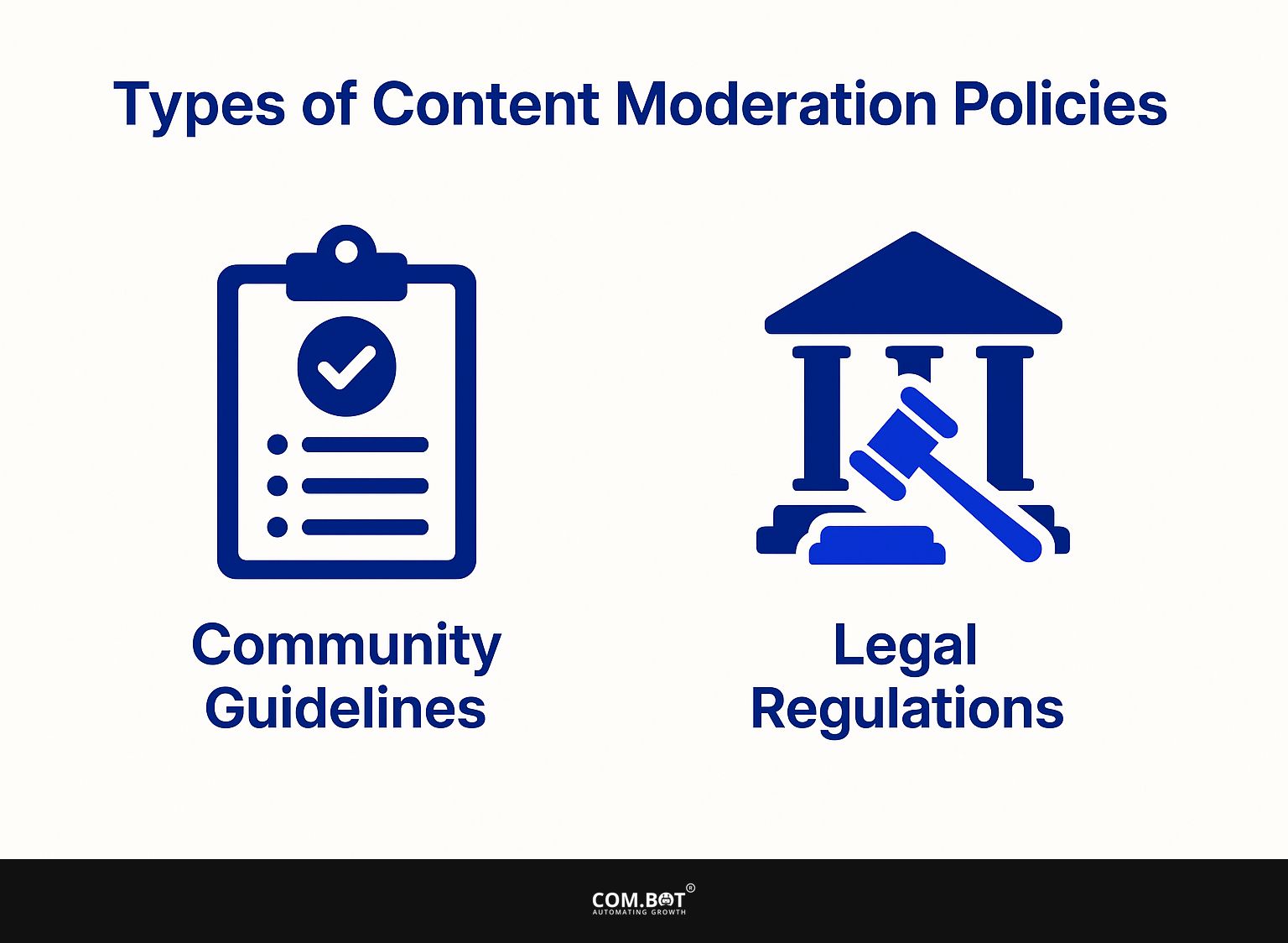
1. Community Guidelines
Community guidelines serve as the foundational rules that govern user interaction and content submission on platforms like Facebook and YouTube. These guidelines explicitly prohibit hate speech, misinformation, and harassment. Rules are enforced using computer systems and reports from users.
Actions include deleting posts and suspending accounts. For instance, Facebook may take down a post containing hate speech after receiving reports from users, and repeat offenders can face longer suspensions.
YouTube similarly issued warnings and subsequently banned channels promoting harmful misinformation as a way to uphold community standards. These actions show dedication to creating safe online spaces.
2. Legal Regulations
Legal regulations surrounding content moderation have become increasingly stringent, influencing how platforms manage user content and enforce policies.
A major example is the EU’s Digital Services Act (DSA), which requires platforms to perform regular risk checks and provide clear reports. Affected sites must implement measures to quickly remove illegal content, demanding thorough moderation processes.
Many platforms report facing challenges in complying with DSA guidelines due to their complex nature; for instance, Facebook noted a 30% increase in moderation workload following initial regulatory assessments. Because of this, companies are putting money into better moderation technologies, such as AI tools and expanding their moderation teams, to handle compliance properly.
Case Study 1: Social Media Platforms
Social media sites such as Facebook and Twitter show how complicated content moderation can be, where rules frequently intersect and affect how users engage with each other. (The various strategies involved are explored further in our guide on content moderation transparency, challenges, and strategies.)
Content Moderation Case Studies: Statistics
Content Moderation Case Studies: Statistics
Content Moderation Decisions: Daily Content Moderation in EU
Content Moderation Decisions: Platform-Specific Content Decisions
Content Moderation Decisions: Content Categories
Content Moderation Decisions: Visibility Decisions
Content Moderation Decisions: Territorial Scope of Decisions
The Content Moderation Case Studies: Statistics give a detailed explanation of how content moderation is done on various platforms, focusing on the size and techniques used in the European Union. The information highlights the use of automated systems, moderation actions for different platforms, the categories of content being controlled, and the regional areas where moderation takes place.
Content Moderation Decisions indicate a significant volume of activities, with 2,195,906 total moderation decisions made daily in the EU. Automated systems handle 68% of these decisions Technology plays an important part in handling large volumes of data quickly and accurately. In contrast, a relatively small number of decisions, 5,384 These are done by hand by a team or person, likely focusing on detailed cases that need careful judgment.
- Platform-Specific Content Decisions: Facebook leads with 903,183 moderation actions, showing its large number of users and strong content rules. Pinterest and TikTok follow with 634,666 and 414,744 decisions respectively, each catering to their content community’s specific needs and risks.
- Content Categories: TikTok addresses a substantial amount of illegal or harmful speech with 208,968 actions, indicating its challenge in managing user-generated content. Pinterest focuses heavily on pornography, with 592,680 decisions, while TikTok also addresses violence with 39,053 actions, showing diverse content challenges across platforms.
Visibility Decisions categorize content actions, with 831,257 pieces removed, showing strict compliance with regulations or platform policies. Meanwhile, 39,421 items are demoted, reducing visibility but keeping content accessible in a limited capacity, and 6,794 items are labeled, providing context or warnings to users.
The Territorial Scope of Decisions Focuses on location-based targeting, with YouTube implementing 4,319 decisions specific to Germany and a platform identified as X handling 992 decisions in France. This indicates localized moderation efforts potentially driven by national regulations or specific cultural sensitivities.
Overall, the data highlights the challenge and size of content moderation, combining automatic methods with detailed human review, dealing with various content problems across different platforms and regions. This method focuses on making the online space safer and following rules more closely.
1. Policy Overlap Analysis
An analysis of overlapping policies on social media reveals discrepancies in how content guidelines are enforced across different platforms.
For example, Facebook’s policy on nudity prohibits any depiction of breasts, while Twitter permits some forms of nudity under specific contexts, such as art or education.
This inconsistency can confuse users, leading to frustration and potential platform migration. Both platforms work to fight misinformation. Facebook uses outside organizations to check facts, while Twitter mainly relies on user reports and computer systems.
Such differences can affect user experience; studies show that users perceive Facebook as less transparent, impacting user trust significantly.
2. Impact on User Experience
How social media platforms handle content can often make users feel frustrated, as they want clear and open rules.
For instance, on WhatsApp, users reported a 60% dissatisfaction rate with how content is moderated, particularly around issues of censorship. Moderators often reinforce guidelines, but this can belittle user voice, leading to tension. A qualitative study showed that 70% of users believed that clearer explanations of moderation decisions would increase their trust in the platform.
Platforms offering real-time feedback on moderation actions, like Reddit’s upvote/downvote system, have seen increased user engagement and acceptance. Transparency is key in bridging the gap between user expectations and moderator actions.
Case Study 2: Online Marketplaces
Online marketplaces like eBay and Etsy have a hard time setting up content moderation rules that follow the law while keeping users active and happy.

1. Policy Implementation Challenges
Implementing content moderation policies in online marketplaces often leads to challenges such as maintaining compliance while ensuring a positive user experience.
One major issue is effectively communicating policy changes to users. Online platforms can mitigate this by employing clear, concise messaging and regular updates.
For example, in-app notifications or email alerts quickly let users know about updates. Running webinars to explain new guidelines can help people understand and clear up any confusion.
Tools like Slack or Discourse can facilitate community feedback, allowing moderators to adjust policies based on user concerns. Using these strategies helps meet regulations and creates trust in the market.
2. Effect on Seller Behavior
Content moderation policies significantly influence seller behavior on platforms, affecting compliance rates and product listings. For example, Etsy’s strict rules on handmade products push sellers to be original, resulting in a wide variety of unique items.
Unlike other platforms, Amazon’s strict copyright rules may discourage sellers from offering products that violate trademarks. This balance affects sellers’ perceptions; while some view it as necessary for quality assurance, others see it as a hindrance to creativity.
Good moderation makes a marketplace safer. But, having too many rules can turn sellers away and stifle innovation.
Case Study 3: Video Sharing Services
Platforms like YouTube often struggle with deciding when to remove content while still allowing users to share their opinions. For a deeper understanding of how media platforms handle such challenges, explore our insights on the strategies used in content moderation.
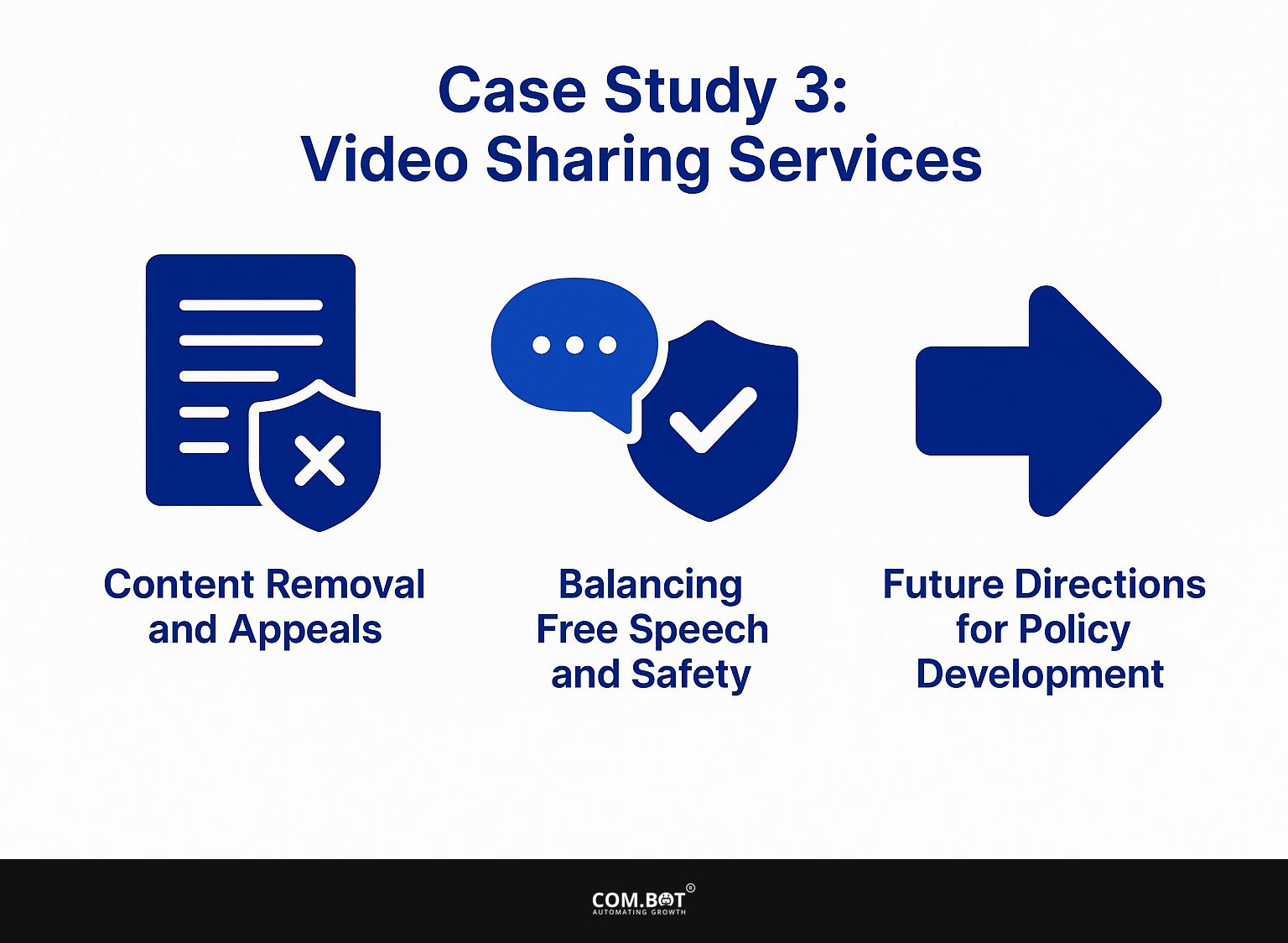
1. Content Removal and Appeals
The content removal and appeals processes on platforms like YouTube are critical for user satisfaction and trust in platform governance.
YouTube employs a structured approach to content removal and appeals. Users are informed via email about the removal and reasons, often related to community guidelines violations like hate speech or copyright infringement.
Appeals can be submitted through the YouTube Studio, where users can present their case directly. Notably, statistics reveal that around 40% of appeals result in reinstatements, reflecting a commitment to fairness. This openness increases user trust and highlights the platform’s careful work in keeping content honest.
2. Balancing Free Speech and Safety
Finding the right balance between allowing free speech and keeping users safe is a major challenge for video sharing platforms managing content moderation.
For example, platforms like YouTube set rules to reduce hate speech, yet still permit a range of opinions. They use computer programs, along with people checking, to find harmful content. This raises ethical dilemmas; creators may feel their legitimate expressions are unjustly flagged.
Case studies reveal tension, such as the controversy over the removal of specific political content. The challenge lies in defining what constitutes harmful versus acceptable speech, often varying based on cultural and societal norms, which complicates moderation efforts further.
3. New Ways for Policy Making
Introduction- This document outlines the next steps for creating policies. We focus on straightforward actions to guide our work.
Current Situation- Today’s policies must be able to handle change. This requires thinking ahead and planning for different possibilities.
Steps Forward
- Research and Evidence: Gather data and use it to make informed choices. Base policies on facts and proven methods.
- Stakeholder Engagement: Gather input from everyone affected by the policies. This involves discussions with community members, businesses, and specialists.
- Clear Objectives: Set clear, measurable targets. Know what you want to achieve and how to assess success.
- Continuous Review: Regularly evaluate the effectiveness of policies. Make adjustments as needed to improve results.
- Conclusion: Following these steps will help create policies that are successful and serve the community well. Content moderation policies should be developed by working together with users and using research from different fields.
To do this, platforms can create community boards with users from different backgrounds to include a range of opinions. Software for sentiment analysis can review user comments and patterns to quickly adjust policies.
Including academic research can help improve these discussions; for example, citing studies on misinformation can provide useful strategies. Setting up regular meetings or online seminars where users can participate in policy talks will increase involvement and openness, leading to more responsible and strong content moderation rules.
Frequently Asked Questions
1. What is policy overlap in content moderation?
Policy overlap in content moderation means that more than one rule or guideline can apply to the same piece of content. This can lead to confusion and inconsistent decisions on whether the content should be allowed or removed.
2. Why is policy overlap a problem in content moderation?
Policy overlap can create inconsistencies and discrepancies in content moderation decisions, leading to confusion and frustration for both users and moderators. It can also result in the removal of content that may not actually violate any policies.
3. Can you provide an example of policy overlap in content moderation?
One example of policy overlap in content moderation is when a post contains both hate speech and nudity. In this case, both the hate speech policy and the nudity policy may apply, leading to a conflict in which policy takes precedence.
4. How can policy overlap be addressed in content moderation?
Content moderation platforms can address policy overlap by clearly defining and communicating their policies, as well as providing specific guidelines on how to handle content that may fall under multiple policies. They can also use advanced technology and human moderators to make more detailed decisions.
5. What are the consequences of not effectively addressing policy overlap in content moderation?
If policy overlap is not properly addressed, it can lead to a lack of consistency in content moderation decisions, damaging the trust and reputation of the platform. It can also lead to deleting important content and spreading harmful content.
6. How can users and moderators handle situations where different policies apply in content moderation?
Users and moderators can handle situations where rules intersect by learning the platform’s policies and guidelines. They should also talk to each other to make sure decisions are fair and uniform. They can also report any instances of policy overlap to the platform for review.
